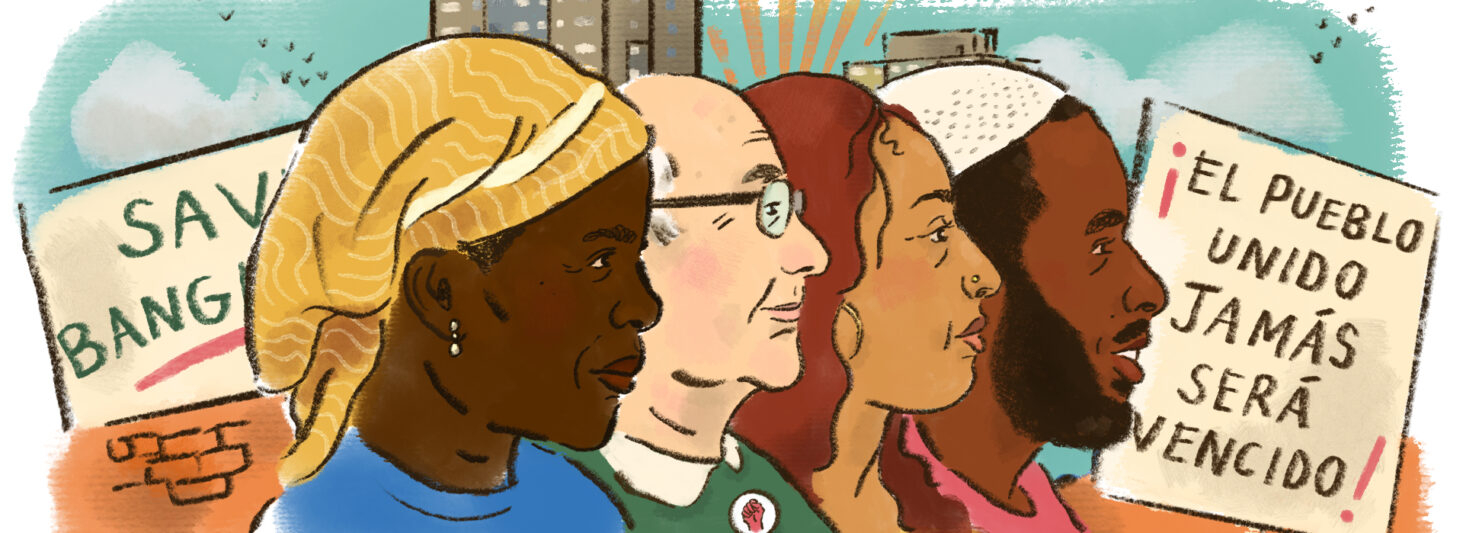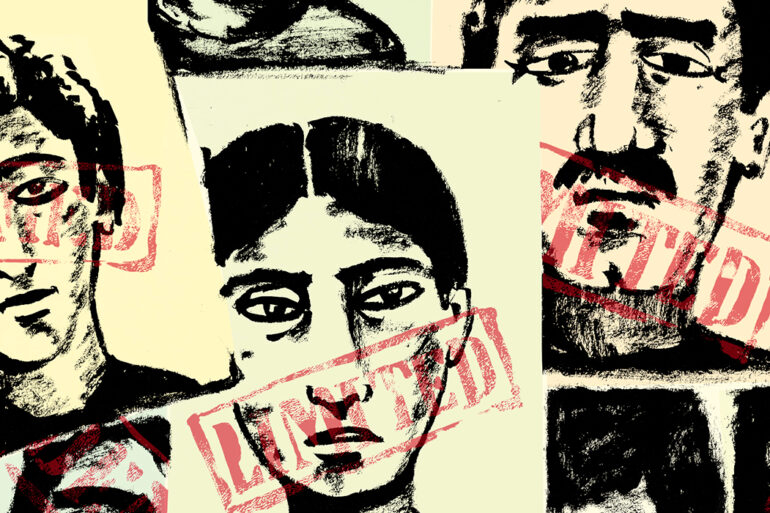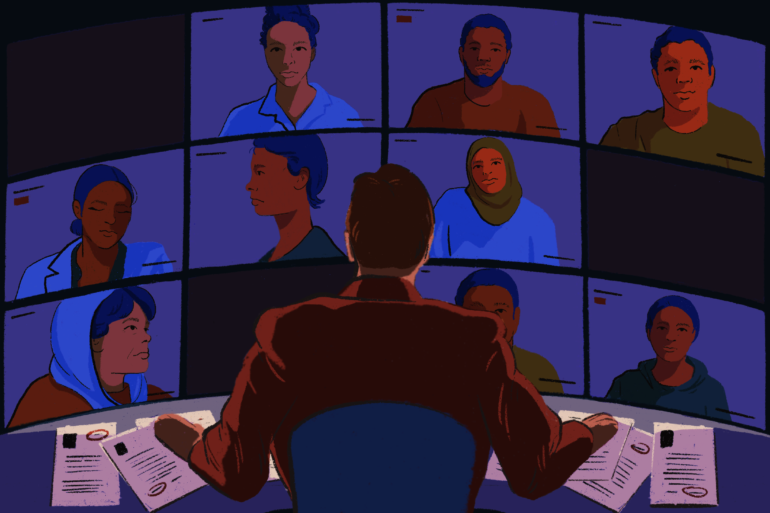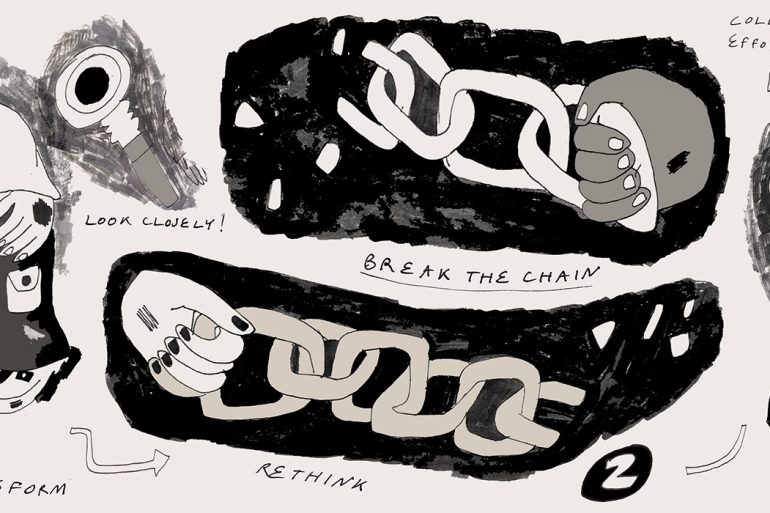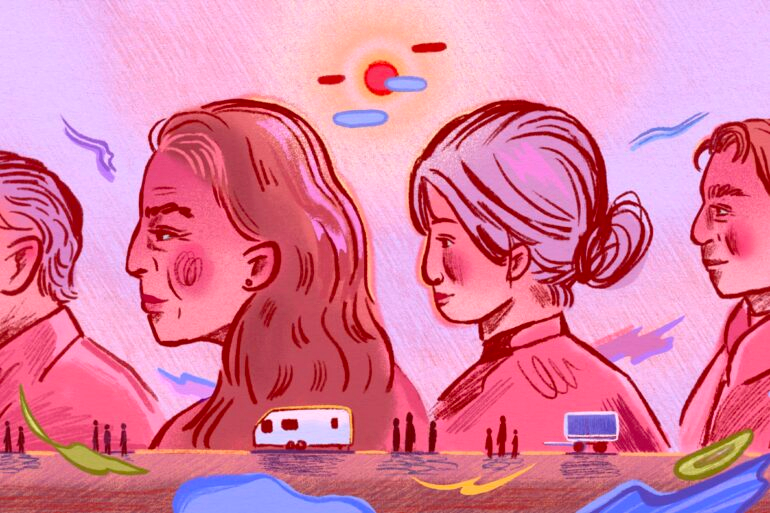What is gentrification?
The term gentrification was coined by Ruth Glass in the 1960s to describe the displacement of working class residents of London neighbourhoods (in particular inner city neighbourhoods) by middle class newcomers.
It is economic displacement, as well as cultural, social and political. What underpins gentrification is not just economic gain, but importantly government complicity: underfunding and giving power to local councils to allow private companies and businesses to buy the land in these areas and thus giving them control of how it is used and developed.
The process of gentrification usually follows these steps.
Step 1. Individual, lower middle class people start moving to these areas and begin to ‘fix up’ area homes. They often move here for the lower costs and access to spaces they could no longer afford in their previous areas such as art studio rent, housing rent, food costs, leisure, social and cultural costs.
Step 2. More middle class people and families begin to buy real estate in the area. Estate agents and investors slowly begin to capitalise on the area being ‘up and coming.’ This is where rent and house prices begin to rise – the first step in pricing out the locals of this area.
Step 3. This is less individual and more large scale. This is where investment and capital is poured into these areas by big businesses, real estate agents and government funded institutions like universities. This is where you see large plots of land – often where parks, social housing estates, or community hubs like markets – are bought up, paving the way for mass displacement.
Step 4. Coming to the final stages of gentrification, we see large scale luxury housing developments that overtake the area, mainly ushering in international buyers and investment.
The cycle is vicious as the original new coming ‘gentrifiers’ from stages one and two are also pushed out into surrounding areas as the rent of these luxury apartments drive all people, culture and life from the area.
A clear example of this is Hackney. Many predominantly white middle class people moved to the area around 10 years ago. Now house prices have driven up so much in the area that these people and families are moving out further east, with areas like Leyton, Black Horse Road and Walthamstow becoming the new settlement spots – and upcoming areas to develop according to developers, where this cycle will continue.
Why is gentrification a race as well as a class issue?
The process of gentrification requires dispossession and displacement in order to achieve this economic gain. Private property and ownership is a tenet of white supremacy that reinforces racial capitalism and racism. Therefore, it is a racialised and classed endeavour.
How we access land and who can inhabit a space is determined by the owners of the land, who are often white and wealthy. It means working class and people of colour have the least access to land, capital and power in this system and are in fact ‘commodifiable’ within it, meaning they can be discarded and disposed of when no longer serving the purpose of generating profit.
Working class people and racialised people in these areas, are often seen as ‘negative investments’ (costs of keeping are higher than the returns/profits made), rather than people who have a right to their homes, neighbourhoods and city. Gentrification is one of the clearest symbols of the tension between the value of the local community and the perceived value of the land.
Thatcherism
In the 80s, Thatcher introduced policies like the abolition of rent controls and deregulation of the market, which since then have given private businesses and companies free reign to privatise land that should have been maintained for social housing and preserving our neighbourhoods.
It has also given landlords the power to evict tenants without a reason, raise rents to unaffordable levels, and force us into dangerous conditions without any consequences. Under Thatcher, we also saw our social welfare system get stripped down to the bones, removing any sort of financial resilience for the original residents of the most gentrified areas.
When Thatcher introduced The 1980 Housing Act, she extended right-to-buy council homes to tenants with generous discounts. In the following decade, through Right to Buy more than a million council homes were sold at an estimated cost (in today’s money) of more than £60bn. The majority of sold-off homes were not replaced, leaving social housing as something people should view as a last resort, and something the state began to neglect.
Not only was Thatcherism embedded in legislation: it’s also embedded in the ideology of British society. To own a home was to have freedom. The idyll of home ownership has long been sold to us as “a good financial investment”, or “increasing mobility”, or “something to leave the family,” and these phrases endure to this day.
This rhetoric, along with many of Thatcher’s neo-liberal policies, marked the beginning of a process of state privatisation, where the state started outsourcing its responsibilities to private profit-geared companies and atomising people and communities into their individual households. Crucially, it meant your right and access to housing became your personal problem, rather than that of the state.
How has gentrification evolved?
While Right to Buy initially was seen as a good thing, with people usually excluded from the housing market able to own their own home, the benefits were starkly unequal. We see this in the state of our housing today. While an older generation of working- and lower-middle-class people gained their first big asset upon buying council homes in the 80s, today, millions of mostly younger people have now been forced into insecure, grotty, privately rented accommodation.
Those who could not afford to use the scheme tended to be working class people, lone parents, younger tenants, people living on their own, or Thatcherism’s “economic losers”: the unemployed or low-skilled. This trend still continues, with these demographics being the private renters more likely to be subjected to very poor housing conditions. Tenants are constantly in fear of eviction, tenants are in no position to demand repairs to the mould, damp and dilapidation that plague the sector with so little regulation.
A combination of low levels of housebuilding, “landbanking” by property developers and the equity pumped into the housing market by Right to Buy sellers carried on driving house prices upwards, while wages failed to keep up. As the first wave of right-to-buy beneficiaries sold up and moved on, ex-council homes started to enter the private rental market in even greater numbers.
This has led to the systematic running down of social housing, especially through managed decline over successive decades. Where once we saw housing as a social need, now it is an investment that prioritises the interests of landlords and speculators who profit from rent and rising property prices.
For London council estates in particular, this has led to widespread decanting of residents to allow for demolition and redevelopment, primarily by private developers who sell the majority of new housing at market rate. This process of decanting has displaced long-term council tenants and shorter-term ‘temporary’ tenants, with many not able to return to the estate.
These tenants are often moved into temporary accommodation for years, are moved to the outskirts or outside of London, or have to wait years on the social housing list for another home. This long waiting period pushes people to rent privately, where they are then subjected to poor and unaffordable housing with private landlords.
At the end of Thatcher’s tenure, 1.5 million council homes had been sold off, and London homes sold made up more than one fifth of this number. Thatcher’s housing legacy cemented the growing inequality, worsening housing affordability, housing supply shortfalls we see today. The deepening housing crisis has been exacerbated by her successors’ austerity, economics and welfare cuts.
How is gentrification linked with higher police presence?
A more insidious impact of gentrification is that gentrifying areas are often subjected to increased police presence, stop-and search practices, aggressive police tactics and surveillance.
In London, the link between increased policing in areas with high populations of working class people and/or people of colour has long been documented. Caribbean migrants of the Windrush generation settling in long since gentrified areas like Notting Hill in the 50s were subjected to vicious police violence and fascists groups like the Teddy Boys. As time has gone on, securitisation and policing has been sewn into the fabric of the UK through legislation that grants the police more powers to enact on the public.
The 2011 riots were a clear marking of these powers being enrolled into the public and the ongoing rise of policing and repression in London and the UK. After the London riots, the language around housing estates was racialised and criminalised. In England and Wales, prime minister David Cameron, London mayor Boris Johnson laid the blame squarely on ‘gangs’, described as a “major criminal disease that has infected streets and estates’ and an obstacle to ‘neighbourhood rejuvenation, community action and business development’”
This developed the racist and classist stigma around Black and multicultural neighbourhoods and council estates. This increased the policing of council estates, with the police force, as usual, acting as a powerful and dangerous arm of the state itself.
At the same time, the Home Office introduced its Ending Gang and Youth Violence (EGYV) strategy, which provides local authorities financial incentives to gather data on young people in gangs or at risk of gang involvement. The Conservative government’s existing Estate Regeneration Programme was also accelerated; involving the selling off of local authority-owned housing estates to private partnerships and the decanting of social housing tenants outside the capital in a process that has been described as social cleansing.
The Gangs Matrix was released in 2012 as well as the Anti-social Behaviour, Policing and Crime Act 2014, leading to sanctions being used against young people, particularly young Black men.
Other policing acts criminalised spaces in our areas and estates associated with Black working class culture. Racist laws like the 696 legislation also targeted night venues, Black music artists (particularly Grime and Drill artists) who were from these areas and targeted as inciting violence in young Black youth.
At the root of this is social deprivation and state failure. Politicians could have looked to the root causes of the riots, such as social pressures due to the, austerity-induced welfare benefit cuts, the closing of youth clubs, aggressive police operations and ill-thought out policies like the ending of the Educational Maintenance Allowance (EMA) that disproportionately affected Black and brown young people.
The criminalisation of working class people, in particular working class Black and brown people, led to a push for these ‘sink’ estates that are perceived to “breed criminality” to be demolished –particularly in areas where the riots took place, such as Tottenham, Camberwell, Hackney, Brixton and Croydon, along with other areas in the capital and and across the UK.
This push for policing, regeneration and gentrification was not only deployed by the MET police, but also local authorities and other social agencies, meaning the police have clearer access to our public records and vice versa which can prove detrimental for young Black and Brown people accessing housing in particular but also other public institutions like education, healthcare and social care.
This is what David Cameron had to say about the riots in 2016:
“The riots of 2011 didn’t emerge from within terraced streets or low-rise apartment buildings. As spatial analysis of the riots has shown, the rioters came overwhelmingly from these post-war estates … Sink estates – and frankly, the people who lived in them – have been seen as something simply to be managed.”
It shouldn’t be a surprise that the police have a role in enforcing gentrification. Police as an institution was formed to protect property, and quell social unrest against the state, especially from working class people.
Gentrification has been used as a way to ‘clean up the city’ – forcibly removing people who make the place ‘undesirable’ and ultimately bring down the profits of developers for an area. Despite a shortage of social and affordable housing being built, the police are deployed to harass people who are street homeless or squatters. We know all too well that Black and brown youth are also targeted, and the police also enact immigration raids to evict migrants from their homes.
Case Study: Newham
The London 2012 Olympics in Newham tie together the issues around gentrification, securitisation, policing and social cleansing. Newham where most of the Olympic Games were situated has the most culturally diverse and youngest population, among the highest concentrations of poverty and deprivation and crime in the UK.
The perception of crime in Newham plays a big part here, because much of the crime that stems from deprived boroughs is as a result of inadequate housing situations, poverty, lack of employment opportunities and underfunding in education. All these issues indicate state failure to tackle issues stemming from poverty at its roots.
Instead, London introduced the London and Paralympic Games Act (2006) to legitimise the use of force to prohibit any protest during the Games – a direct repression tactic to stop the locals protesting the social cleansing happening in Newham. Additionally, the planning of the Olympics infrastructure used the ‘Secured by Design’ framework, wherein city planners consulted with the Met Police.
What came out of this was an array of surveillance technology that was deployed for the Games: scanners, biometric ID cards, number-plate and facial-recognition CCTV systems, disease tracking systems and checkpoints. These would then be used in the surveillance of working class Black and Brown people, particularly young people in Newham. They would be disproportionately surveilled, stopped and searched and harassed by the police.
The use of surveillance and policing in gentrification not only ensures capital interest and private property is protected, but those who are deemed ‘risky’ towards these interests are heavily policed until there is an opportunity to disappear them completely, whether that’s through the prison system or through displacement in housing.
In order to facilitate the Olympic Games stadiums, Westfield and the Olympic Village, demolitions of social housing in Carpenters’ Estate and Clays Lane Estate occurred – further exacerbating the lack of social housing provision in a borough that has the highest number of households in temporary accommodation.
Initial plans for the London 2012 Olympics had claimed the Olympic Village, composed of 4,500 flats, would be converted to private and social housing, the latter to be divided between affordable homes for the shared ownership market and socially rented housing. The Olympic Village eventually resulted in 2,818 flats – nearly 60% less than the initial figure advertised in official brochures at pre-bidding stage – at a cost of £1 billion to the taxpayers.
In 2011, the Olympic Delivery Authority (ODA) sold 1,439 properties in the Olympic Village to Qatari Diar and UK property developer Delancey Estates for £557 million. The remaining 1,379 properties were sold in 2009 for £268 million to Triathlon Homes which have been appointed to oversee the conversion and sale/rent of the apartments. This has resulted in a deficit to the public resource of £175 million.
This tells us that these homes were built for profit rather than people. The focus in Newham should’ve been for people to access safe, affordable housing, but instead these homes are left empty, their rents unaffordable to the local people in the area.
How is gentrification a climate justice issue?
Gentrification is both a climate and social justice issue not only in the fight against carbon emissions, but the right to land and space.
Social housing estates across London are up for demolition. The problem is, demolishing and rebuilding estates is far from sustainable. Construction, along with the energy required to heat, cool and power buildings, is estimated to account for almost 40% of global greenhouse gas emissions.
Local councils in London are calling for a climate emergency, while approving demolition projects on social housing blocks that could be used to house over one million people on social housing waiting lists. across London is beyond contradictory.
Many of these social housing estates are already structurally safe to live in. In a lot of cases, retrofitting, rather than demolition, would be the best way to reduce carbon emissions and pollution from new construction and still provide the warm, dry affordable homes that are desperately needed in the city. Doing this would not just be more sustainable for the environment but would also safeguard truly affordable social housing for the next generation.
Our homes across London are expensive and poorly maintained with mould, damp and drafts, as well as inadequate ventilation, heating and insulation. Improving the quality and energy efficiency of homes will both decrease the carbon footprint of housing and improve tenants’ circumstances; reduced energy bills will lift households out of fuel poverty, and housing upgrades will help tackle many health and wellbeing issues in London caused by poor housing.
Along with this, climate justice intersects with where people are placed in cities. Social housing estates, particularly where there’s high populations of working class people of colour are more likely to be placed by busy roads, incineration sites like in Edmonton, Beckton and Lewisham.
This exposes working class, Black and brown people to a higher level of air pollution, toxins and waste. The links between poor air quality, health, race and housing have unfortunately been highlighted in the tragic death of Ella Kissi-Debrah. The coroner ruled a causation between poor air quality and Ella’s fatal asthma attack, due to being exposed long term to extremely high levels of air pollution. Ella lived near the South Circular in Lewisham, one of the busiest roads in London.
Poor air quality and carcinogenic toxins also come from demolition and redevelopment. Clean Air for Southall and Hayes (CASH) have been tirelessly campaigning to stop the redevelopment of the Old Gas Works in Southall where exposure to benzene and poor air has exacerbated local people’s breathing difficulties, chest pains, and cancer. The redevelopment is also to build more new homes, but with gentrification now expanding beyond inner city london and into outer London, it is also unlikely these homes will be affordable too.
Ultimately, the fight for a liveable planet, encompasses the fight for warm, safe, secure, affordable housing. Environmental journalist Sharlene Gandhi put this beautifully:
“ ‘just housing’ is much more than just the physical structure of a home itself: it’s about where that home is, its long-term viability and resilience, what ‘community’ looks and feels like, access to green space and amenities, and affordability beyond property ownership.”
How can we resist gentrification?
Collectively fighting back is something we’ve always done and can continue to do to resist gentrification.
When we talk about resisting gentrification, rogue landlords and developers, working class people, people of colour, and LGBTQI+ people have always been at the forefront of that resistance.
Some examples that stick out to me are Nijjormanush’s Save Brick Lane campaign which was led by the Bengali community. The gentrification of Brick LLane, in particular the Truman Brewery, would lead to several independent family businesses being shut, families being pushed out of their homes in the area and a loss of the history, culture and community effort it took to build this area in the first place.
Bengali community organisers from Nijjormanush and locals from Brick Lane fought back at this campaign by community organising, taking to the streets to highlight the history of the area and creating a pledge for all Londoners to sign, presenting it to the mayor to stop this from happening.
I particularly love this campaign because, since arriving in Brick Lane in the 70s, the Bengali community’s history of migration has always been tied with anti-racism and housing justice. Many families squatted in properties across Spitalfields and Brick Lane in order to keep the houses in the area, while also organising against fascists constantly attacking them through the decade. This Save Brick Lane campaign is still ongoing and feels like a continuation of the organising tradition started by many of their parents and grandparents.
Another incredible anti-gentrification campaign is Save Latin Village. Latin Village occupies the Seven Sisters Indoor Market in Tottenham and is a vibrant hub of Latin American businesses and migrant communities.
From childcare, to money, to living assistance, to support with employment and immigration – The Latin Village provided a home for so many. Property developer Grainger PLC wanted to build 190 build-to-rent flats on the site, with no affordable housing provision. The flats would have required the demolition of the historic Wards Corner building and market, which could have displaced poorer residents from the area. The Latinx community in Seven Sisters, across London and the locals in the area did not sit back without a fight. The strength of the campaign was its coalition. Across local business owners, residents, market stalls union, they were able to insource skills like advocacy, comms and campaign tactics from across the coalition.
The beauty in this campaign for me came from their approach. Save Latin Village made huge efforts to eliminate elitism from their spaces and get all people involved. They worked to make spaces safe for marginalised groups and centre Afro-LatinX traders, alongside other anti-gentrification campaigns like ‘Latin Elephant’, ‘Save Ridley Road’ and ‘Save Brick Lane’, showing support and solidarity for Save Latin Village.
It’s in these moments we realise the power is between us and we only have each other. In 2021, after 15 years of relentless campaigning, organising and public pressure the Save Latin Village campaign finally won council backing for a community plan for the site.
Here to stay, here to fight, housing as a collective right!
Resisting gentrification is resisting the demolition of social housing estates that otherwise would provide secure housing for its residents and preserve the communities that exist there. An example of a winning campaign is People’s Empowerment Alliance for Custom House, otherwise known as PEACH. A group of families campaigned against major managed decline, disrepair and unreasonable rent rises. They not only won by being reabsorbed back into Newham Council (which had been managed by property manager Mears for years), but they also secured a rent reduction of about 60% and repairs secured from Newham Council for the awful disrepair in the home and the estate.
For many families on the estate, this was life changing – not just because of the material conditions they changed, but because they themselves realised they achieved this in their own might as a community. None of these families were organisers and campaigners until life and their housing conditions made them. Individually they were outnumbered, but coming together as a community to make collective demands of the council (the power-holder) is what brought the results.
What can we learn from this?
In all these instances of resistance. We learn these things:
- We need to identify our power holder(s). Whether that’s the council, a private landlord or developer for example. This is the target who is enacting the problem, they are also the people who have the power to change the problem.
- We need to build collective power amongst people. Alone, we aren’t heard and aren’t as powerful. Together, we can build collective demands and concede the power holder to give us our demands. When Malcom X says “Power never takes a back step – only in the face of more power,” it tells us not only what we’re up against, but how we win. We win by building power, alliances and goals around a common good or purpose. We win by making it impossible to not be involved in the fight.
- There is no fight without our community. Community organising educates and activates our streets, neighbours, borough and city to take a stand. We need to actively be talking to people, going into community spaces, centres, religious centres and all the places people gather socially to talk to them and politicise them into action. Without putting in the work to do this, we have fewer people willing to join the fight.
- Our lives and personal stories are meaningful in this. We all have our own personal stories to tell about our homes, estates and communities. Being able to share this with your neighbours and the allied press and networks you have is a means of connecting to each other and our experiences. We aren’t alone in these and that is the beginning of turning our loss of community, secure and affordable housing from a personal issue into a collective one.
- Housing and gentrification is political. It is a long orchestrated game by the state and private beneficiaries like developers and landlords who benefit from this rigged housing system. It’s driving homelessness, poverty and social cleansing. Unless we make big changes, many of us will be stuck renting overpriced and poorly maintained housing for the rest of our lives.
Where do we go from here?
The ending of this is not just that we persisted, it’s that we fought, we won, we remembered, we kept alive and didn’t roll over because they told us to. It means we cared about our neighbours more than the promise of unequal and unattainable wealth through gentrification and displacement. We reject the idea that regeneration starts with people like us being gone from these hoods.
I want to end by keeping our memories alive. The spaces we can only describe or share a photo of. The blocks and spaces that are no longer with us, or no longer what they once were. The spaces and blocks that nurtured us, exposed us to the good, bad, ugly of life, and ultimately made us who we are. I asked people to share what came to their heart when thinking of their estate and this is what they brought me. I hope it moves you as much as it did me.
To all the blocks we’ve ever loved, this is our ode to you:
Heygate estate (Demolished, RIP) – “Nothing hurts me more than Heygate Estate man. I can’t lie, as a kid there were defo things that happened there i shouldn’t have seen, but boy, that was home. Like I knew everyone on the estate and ultimately I did feel safe there, we were a proper community. I don’t even recognise Elephant anymore.” (Matthew, 28, 2023)
Nightingale Estate, Hackney (mainly demolished) – “As much as this was a no go zone in the press, the reality was a close knit community. Not to excuse the madness but to say this place is home to a lot of people. We looked out for each other” (Liyah, 43, 2023)
Aylesbury Estate (set to be demolished) – “I still live here, I’ve been here all my life, and to be honest people from my primary school upwards are still here too. I’m sad it’s getting demolished. It’s a good estate with spacious homes and a good structure. It’s messed up Southwark council is allowing it to become a mess. Where will we all go? Aylesbury estate will always have my heart.” (Belinda, 28, 2023)
Ledbury Estate, Peckham (demolishing) – “I grew up here, i learned to kick ball here, ride a bike here and met my friends for life. It’s crazy it’s getting knocked down but big up Ledbury Estate- that’s home right there.” (Jeffrey, 32, 2023)
Pepys Estate, Deptford – “Growing up in Deptford between 1999- 2012 was crazy times but shout out Pepys Estate to the world and back, i wouldn’t be me without it.” (E, 28, 2023)
Angell Town Estate, Brixton – “I remember when this area was a no go zone when I came to England in the 80s. It’s changed a lot but the community has always remained. I’ve been here 20 years and wouldn’t imagine living anywhere else, all ups and downs included.” (Michael, 59, 2023)
Cowley Estate, Oval – “I remember going to Vassall road youth club as a kid and that being my biggest motive. The estate has changed loads but I’m glad I have so many memories here man.” (Oz, 21, 2023)
Stockwell Gardens Estate, Stockwell – “ When I think about what radicalised me, it’s the community on estates that did that for me. I remember growing up here, parents would look after each other’s kids, oversee us playing in the pitch, and share meals for Christmas and Iftar. The dad’s of the estate would even break up fights and cut off the clamp of your car so you didn’t have to pay to get it off. Growing up here showed me the true meaning of solidarity. We all need each other. ” (Simmone, 26, 2023)
Brandon Estate, Camberwell – “word to Adele, this is my hometown glory for real. Too many core memories wrapped up in this place.” – (Richard, 32, 2023)
Redbrick Estate, Lea Green – “I love my community and the solidarity we have between us” (R, 26, 2023)
North Peckham Estate, Peckham – “No matter how others may view it, negative or otherwise, it’s a community. Home” (M, 28, 2023)
Broadwater Farm estate, Tottenham – “These are the people I’ve grown up with, they’ve seen it all and so have I. we may have our differences but we love each other and it’s nice to know your neighbours. That doesn’t happen too much anymore.” (Efya, 29, 2023)
Winstanley estate, Wandsworth – “Growing up here was crazy, but it’s home.” (J, 27, 2023)
What can you do?
Fighting for better housing and the rights to our neighbourhood is a big fight, but not an impossible one. The key thing is to identify the problem(s) of your estate/block, such as major disrepair, increasing rents, loss of community centres of flats, loss of a market/hub, see who the power holders are and mobilise people around a common cause. I would identify if there are any existing anti-gentrification campaigns in your area already such as Save Nour or Save Latin Village and see how you can get involved in their campaigns or organising. I would recommend joining the London Renters Union, a union made up of renters building grassroots power to transform the housing system. I would also recommend looking at if your estate already has a tenants union or association you can join and begin organising through there.
Tenants associations often do have relationships of varying degrees to the council and that can either hinder or support your progress. The key here is to continue building community power with the people in your estate so you stand powerful in rooms with decision makers like the council. In this instance I’m thinking about Dora Boatemah of Brixton’s Angell Town Estate. She built estate power against lambeth council by establishing a tenants association in the estate.
Finally, coming together as people of our blocks, estates and communities is to collectively imagine what a thriving estate looks like for us that live there. This could encompass things like space for grief, trauma and collective healing, building community in the estate, education (political and otherwise) + imagination, getting first response training (that doesn’t involve calling the police), and art + creativity opportunities within it too. If we are able to collectively envision it, we are able to collectively build it.
Resources:
- Gentrification is Not inevitable- Winfred Curran
- LRU member’s handbook 2023.pdf – Google Drive
- Rioting, Legislation and Estate Demolition: A Chronology of Social Cleansing in London, 1999-2019 – architectsforsocialhousing
- Privatise the Mandem – Nabil Al-Kinani
- Leave your fragility at the shore survival podcast
- Land grab, gentrification colonialism and black fatherhood- The Fire this time Podcast
- Colonising the inner City – gentrification and the geographies of colonialism
- Stream E098 Richard Yeboah: Hackney, housing & gentrification by Surviving Society | Listen online for free on SoundCloud
- The Runnymede Trust | A struggle of memory: the history of the Bengali squatters movement
- The-London-Clearances-Race-Housing-and-Policing.pdf (irr.org.uk)
- Pushed to the Margins (runnymedetrust.org)
- Municipal Dreams by John Boughton | Waterstones
- From Sylhet to Spitalfields – Lawrence Wishart (lwbooks.co.uk)
- The Battle for Brick Lane: A History of Resistance – BRICKS Magazine
- Custom House: What it’s like to live under the threat of demolition | openDemocracy
- These 122 council estates in London are up for demolition (timeout.com)
- ‘A massive betrayal’: how London’s Olympic legacy was sold out | Olympic legacy | The Guardian
- (27) Urban Regeneration and Surveillance in Post-Olympic East London A Survey-Based Study of Local Residents Attitudes | Susi Lovati – Academia.edu
- London Olympic legacy of unaffordable housing – Socialist Party
- The Housing Rebellion is growing — RADICAL HOUSING NETWORK
- What just housing policies mean for climate justice – Shado Magazine (shado-mag.com)
- Sink estates are people’s homes – they don’t need to be demolished | Greg Foster | The Guardian
- Why The Built Environment – Architecture 2030
- Confronting injustice: racism and the environmental emergency | Greenpeace UK
- Black residents living in ‘sacrifice areas’ amid air pollution dangers – Voice Online (voice-online.co.uk)
- staying-put-web-version.pdf (wordpress.com)
People to follow:
- Save Nour
- Save Latin Village
- Nijjormanush
- Fight4aylesbury
- Clean Air for Southall Hayes
- The London Renters Union
- Richard Yeboah
- 4Front project
- Nabil Al-Kinani/ Privatise the Mandem
- @Joris_Explains
- @Donell (thedtw):: Specifically their ‘what’s on your nasty old mind’ TikToks documenting inner city areas in london before their regeneration/gentrification
- @Itsthatguyfromends: specifically their ‘estates’ TikTok series
- @ggtheillustrator: incredible illustration work inspired by London estates


